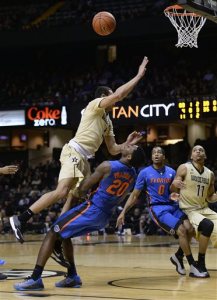Vanderbilt guard Wade Baldwin IV (4) is fouled by Florida guard Michael Frazier II (20) as he drives to the basket in the first half of an NCAA college basketball game Tuesday, Feb. 3, 2015, in Nashville, Tenn. (AP Photo/Mark Zaleski)
Abdul-Malik Abu, Devin Thomas
North Carolina State’s Abdul-Malik Abu, right, fouls Wake Forest’s Devin Thomas, left, during the second half of an NCAA college basketball game in Winston-Salem, N.C., Tuesday, Feb. 3, 2015. Wake Forest won 88-84. (AP Photo/Chuck Burton)
Paschal Chukwu, Joshua Smith, Isaac Copeland
Providence center Paschal Chukwu (13) attempts to shoot between Georgetown center Joshua Smith (24) and forward Isaac Copeland (11) during the first half of an NCAA college basketball game, Wednesday, Feb. 4, 2015, in Washington. (AP Photo/Alex Brandon)
Andrew Harrison, Kenny Gaines, Nemanja Djurisic
Kentucky’s Andrew Harrison (5) loses the ball between Georgia’s Kenny Gaines, left, and Nemanja Djurisic during the second half of an NCAA college basketball game, Tuesday, Feb. 3, 2015, in Lexington, Ky. Kentucky won 69-58. (AP Photo/James Crisp)
..
Prev
1 of 4
Next
.
With scoring plunging to historic lows, the NCAA said Friday it will experiment with a shorter shot clock at this year’s NIT to see if that can jumpstart college basketball’s lagging offense.
The tournament will feature a 30-second shot clock instead of the traditional 35-second clock that has been in play since 1993, with officials examining the effect on the games and taking the data to the men’s basketball rules committee for review in May.
“Without actually implementing it in a game, you’re just talking about it in theory,” Dan Gavitt, NCAA vice president of men’s basketball championships, said on Friday. “By actually putting it in a game with good teams, great coaches, competitive situations over a three-week time period, you’ll actually get results and data that can either verify some of your theories or dispute them.”
The NCAA will also expand the restricted area under the basket from 3 feet to 4 feet to see if it curbs the amount of collisions at the rim. Coaches who play in the tournament will be surveyed about their experience, and the rules committee will look at all the data to consider future rules changes, which could be adopted as soon as May if they gain enough support.
“Although the committee will discuss a number of potential rules changes at the meeting, having specific data on these two rules should help the committee make a decision about whether such potential rule changes might further improve the flow and competitiveness of college basketball,” said Belmont coach Rick Byrd, chairman of the committee.
Last year, Division I men’s teams averaged 67.5 points per game, the lowest number since the 1951-52 season. The 35-second clock and a more physical style of play that has evolved over time are among the biggest factors coaches point to when identifying reasons for the decline.
When current Brooklyn Nets coach Lionel Hollins coached the Memphis Grizzlies in 2011, he said he couldn’t even watch his son Austin play for the University of Minnesota because the college game was too boring.
“I watched Wisconsin and Minnesota play down the stretch and I couldn’t take it,” Hollins said then. “They just hold the ball and hold the ball, and try to get a shot with 10 seconds on the clock.”
Badgers coach Bo Ryan has used the slow-down tactics to great success, including last year’s run to the Final Four and a 20-2 start this year that has Wisconsin ranked No. 5. Wisconsin ranks 39th in the country at 74.4 points per game this season, but many teams at schools both big and small have employed a more deliberate offensive system over the years to neutralize athletic shortcomings.
“We are headed this year, for many different reasons, to probably the fewest number of possessions in the game that we’ve had in the history of our game,” Gavitt said. “There are a lot of different factors involved in that. Some would argue having a shorter shot clock would add more possessions to the game thus giving the opportunity for more offense. We’ll see.”
Years ago, the NCAA would occasionally test out potential rules changes in tournaments like the preseason NIT or the Maui Invitational. But those events have become high-profile showcases in this day and age, so coaches have generally preferred to experiment in exhibition games that usually feature overmatched opponents from lower divisions.
The NCAA says the NIT provides a more evenly matched laboratory. It could also bring new interest to a venerable event that goes largely unnoticed on the national scene while March Madness hogs the spotlight.
“I think that’s a nice potential secondary benefit of this decision,” Gavitt said. “It isn’t what drove this decision by any stretch. But sure. There are good teams, great coaches, great players. The more attention we can bring to the event for the benefit and experience for all those involved with it, the better.”

